The basic thrust of the scenario is that the Combine is attacking a PanEuropean spaceport in Frederikshavn, Denmark, with a coordinated attack by GEVs and an Ogre MK-IIIB sent across the North Sea. The PanEuropean player has to hang on long enough for enough reinforcements to arrive to push back the invaders.
The biggest changes were that victory points were now given only for destroying the critical objectives; the spaceplane itself and six critical structures (adminstration buildings, fuel depots, and workshops). No points are awarded for destroying enemy units or the various town areas.
Here’s the setup for the game before the units were placed. The spaceplane is near the upper edge of the board, buildings and fuel depots scattered nearby, with swamp and forest in the middle of the board. The thin brown strips are road, the large brown blocks are town areas, which favor infantry greatly (triple defense!).
The PanEuropean defender (me) placed my Fencer (an Ogre with a whole lot of missiles and weak guns, code named “Rommel”) right in the middle, with a mobile howitzer, a couple of missile tanks and infantry scattered about. The Combine attackers decided to divide their forces into two groups, each running up one edge of the board. You can see them in the upper-left moving through the few strips of solid ground between the swamps and forest. Unfortunately for the attacker, the defenders scored a very lucky roll right off the bat and took out two GEVs with one shot thanks to spillover fire (those two white puffs on the right side).
Eventually the attackers moved their remaining GEVs and Ogre MK-IIIB (code named “Skorzeny”) up the left flank and took out the large building. 35 victory points in the bag. One of the GEVs was lost in the process, but the attacking Ogre was completely undamaged.
Meanwhile, on the right flank, the attacking force of GEVs and a GEV-PC carrying a platoon of infantry raced up and got close to striking distance of the spaceplane itself. 10 structure points of damage and it would be a guaranteed marginal victory for the attackers. Fortunately, the defenders had committed their Fencer to staving off the threat. Between the Fencer and the mobile howitzer (which, despite the name, wasn’t all that mobile in the town area, only moving one inch per turn, but it did have the advantage of double defense) the threat was largely neutralized (completely so in the next turn or two, especially thanks to some fortuitous reinforcements in that sector).
Finally, the attacking Ogre Mk-IIIB was left alone. Only the one building had been destroyed, all of its screening GEVs destroyed, and the Fencer and scads of reinforcements (mostly GEVs and Light GEVs) rushing to engage. In two turns, the Fencer and the defending tanks and GEVs took out almost all the weapons on the Mk-IIIB, and the attacker threw in the towel. End result: marginal defender victory.
On the whole I’m very pleased with the way the scenario has turned out. Although this was something of a lopsided result, things would have turned out very differently had the attacker simply switched his forces running up the sides of the board. As it was, his Ogre ended up on the side that was furthest from the primary objective and most of the victory point-rich buildings. If the Ogre had been on the right instead of the left, we could easily have seen a couple more buildings taken out for a tie or even a marginal attacker victory.
Now, on to the con! (I’ll post the pdf of the scenario after the convention, for anyone who might be interested.)


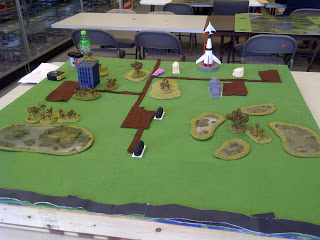
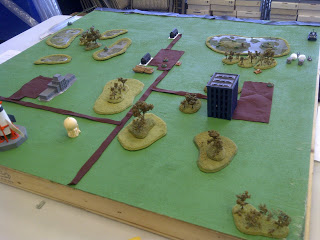
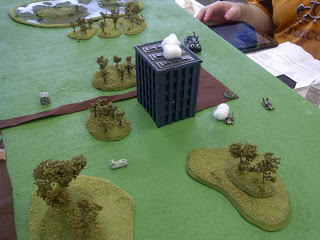
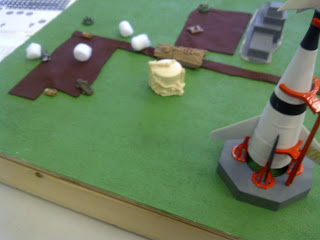
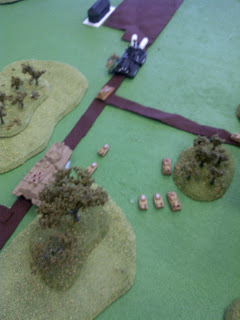







OGRE is one thing I've yet to experience in my gaming and convention career. My only knowledge of it comes from your finely crafted posts and pictures, and scant memories of ads from magazines in the past. I'm strangely in awe of the concept and I always clue in when i see them featured here. Thanks Joe!
In mine own defense, I placed the OGRE on the other side to specifically avoid what happened the last time, which was a massive furball between competing OGRES that bogged down instantly. I was hoping that putting the OGRE on the other side would let it advance at its steady rate while the GEV's bogged down defenses on the other side of the board for a while longer.
I think a combination of that initial mistake (not quite good enough to call a failed plan) and some tremendous luck by the defender really screwed the pooch.